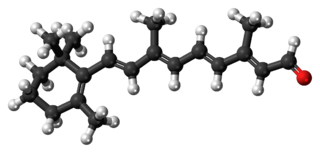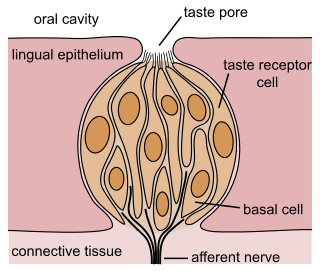
Hummingbirds are birds native to the Americas and comprise the biological family Trochilidae. With about 360 species, they occur from Alaska to Tierra del Fuego, but the vast majority of the species are found in the tropics. They are small birds, with most species measuring 7.5–13 cm (3–5 in) in length. The smallest extant hummingbird species is the 5 cm (2.0 in) bee hummingbird, which weighs less than 2.0 g (0.07 oz). The largest hummingbird species is the 23 cm (9.1 in) giant hummingbird, weighing 18–24 grams (0.63–0.85 oz). They are specialized for feeding on flower nectar, but all species consume flying insects or spiders.

Retinal is a polyene chromophore. Retinal, bound to proteins called opsins, is the chemical basis of visual phototransduction, the light-detection stage of visual perception (vision).

Sweetness is a basic taste most commonly perceived when eating foods rich in sugars. Sweet tastes are generally regarded as pleasurable, except when in excess. In addition to sugars like sucrose, many other chemical compounds are sweet, including aldehydes, ketones, and sugar alcohols. Some are sweet at very low concentrations, allowing their use as non-caloric sugar substitutes. Such non-sugar sweeteners include saccharin and aspartame. Other compounds, such as miraculin, may alter perception of sweetness itself.
Aftertaste is the taste intensity of a food or beverage that is perceived immediately after that food or beverage is removed from the mouth. The aftertastes of different foods and beverages can vary by intensity and over time, but the unifying feature of aftertaste is that it is perceived after a food or beverage is either swallowed or spat out. The neurobiological mechanisms of taste signal transduction from the taste receptors in the mouth to the brain have not yet been fully understood. However, the primary taste processing area located in the insula has been observed to be involved in aftertaste perception.
Charles S. Zuker is a Chilean molecular geneticist and neurobiologist. Zuker is a Professor of Biochemistry & Molecular Biophysics and a Professor of Neuroscience at Columbia University. He has been an Investigator of the Howard Hughes Medical Institute since 1989.
Stuart L. Schreiber is a scientist at Harvard University and co-Founder of the Broad Institute. He has been active in chemical biology, especially the use of small molecules as probes of biology and medicine. Small molecules are the molecules of life most associated with dynamic information flow; these work in concert with the macromolecules that are the basis for inherited information flow.

Growth hormone receptor is a protein that in humans is encoded by the GHR gene. GHR orthologs have been identified in most mammals.

A taste receptor is a type of cellular receptor which facilitates the sensation of taste. When food or other substances enter the mouth, molecules interact with saliva and are bound to taste receptors in the oral cavity and other locations. Molecules which give a sensation of taste are considered "sapid".

Taste receptor 2 member 38 is a protein that in humans is encoded by the TAS2R38 gene. TAS2R38 is a bitter taste receptor; varying genotypes of TAS2R38 influence the ability to taste both 6-n-propylthiouracil (PROP) and phenylthiocarbamide (PTC). Though it has often been proposed that varying taste receptor genotypes could influence tasting ability, TAS2R38 is one of the few taste receptors shown to have this function.
Danielle Renee Reed is an American geneticist employed at the Monell Chemical Senses Center in Philadelphia, Pennsylvania. She is most notable for her papers regarding genetic variation in taste and obesity in mice and humans.

Taste receptor type 2 member 1 (TAS2R1/T2R1) is a protein that in humans is encoded by the TAS2R1 gene. It belongs to the G protein-coupled receptor (GPCR) family and is related to class A-like GPCRs, they contain 7 transmembrane helix bundles and short N-terminus loop. Furthermore, TAS2R1 is member of the 25 known human bitter taste receptors, which enable the perception of bitter taste in the mouth cavity. Increasing evidence indicates a functional role of TAS2Rs in extra-oral tissues.

Taste receptor type 2 member 3 is a protein that in humans is encoded by the TAS2R3 gene.

Taste receptor type 2 member 4 is a protein that in humans is encoded by the TAS2R4 gene.

Taste receptor type 2 member 8 is a protein that in humans is encoded by the TAS2R8 gene.

Taste receptors for bitter substances (T2Rs/TAS2Rs) belong to the family of G-protein coupled receptors and are related to class A-like GPCRs. There are 25 known T2Rs in humans responsible for bitter taste perception.

Taste receptor type 2 member 5 is a protein that in humans is encoded by the TAS2R5 gene.

Taste receptor type 2 member 19 is a protein that in humans is encoded by the TAS2R19 gene. It seems to be involved in the perception of salt and bitter tastes.

Brian Kent Kobilka is an American physiologist and a recipient of the 2012 Nobel Prize in Chemistry with Robert Lefkowitz for discoveries that reveal the workings of G protein-coupled receptors. He is currently a professor in the department of Molecular and Cellular Physiology at Stanford University School of Medicine. He is also a co-founder of ConfometRx, a biotechnology company focusing on G protein-coupled receptors. He was named a member of the National Academy of Sciences in 2011.

The gustatory system or sense of taste is the sensory system that is partially responsible for the perception of taste (flavor). Taste is the perception produced or stimulated when a substance in the mouth reacts chemically with taste receptor cells located on taste buds in the oral cavity, mostly on the tongue. Taste, along with olfaction and trigeminal nerve stimulation, determines flavors of food and other substances. Humans have taste receptors on taste buds and other areas including the upper surface of the tongue and the epiglottis. The gustatory cortex is responsible for the perception of taste.

Mary J. O'Connell is an evolutionary genomicist and Associate Professor at the University of Nottingham. She is the Principal Investigator of the Computational & Molecular Evolutionary Biology Group in the School of Life Sciences at the University of Nottingham.










